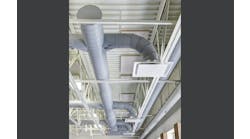According to the Department of Education and the U.S. General Accounting Office, about 20 percent of the nation's schools have problems linked to indoor air quality (IAQ). Poor IAQ can directly affect the comfort and health of the students, teachers and staff who spend their days in elementary and secondary schools. Numerous studies have linked poor IAQ to respiratory illnesses, allergy and asthma symptoms, headaches and fatigue — problems that can lead to student and teacher absences and productivity problems in the short-term, and chronic illness in the long-term.
The issue of IAQ is so important that several state legislatures are addressing it. Most of the proposed legislation centers on developing standards and guidelines for school IAQ, and inspecting schools to ensure good IAQ for students, teachers and staff. The Environmental Protection Agency offers IAQ Tools for Schools — a program that provides strategies for helping schools prevent and resolve IAQ issues.
Good IAQ depends on many factors. One is effective filtration, which provides the primary defense for building occupants and HVAC equipment against particular pollutants. Fortunately, higher standards in filtration have made it possible to produce cleaner, purer air and reduce IAQ problems. This contributes to a better learning environment for students, improved performance among teachers and staff, and an overall sense of comfort, health and well-being.
IAQ problems
The average human breathes in about 16,000 quarts of air each day. And each quart of air we breathe has about 70,000 visible and invisible particles. The EPA notes that indoor air often is more polluted (typically two to five times more and occasionally 100+ times more) than outdoor air. Most of the “respirable” dust and particles people breathe into their lungs is about three microns or smaller — a fraction of the size of a grain of sand.
Filter efficiency
Selecting HVAC filters based on the needs of the facility instead of simply their initial costs naturally will lead to a review of filter efficiency as a determining factor. Simply put, filtration efficiency defines how well the filter will remove contaminants. Low-efficiency filters typically are used to keep lint and dust from clogging the heating and cooling coils of an HVAC system. Medium- and high-efficiency filters typically are used to remove bacteria, pollen, soot and other small particulates.
Initial and sustained efficiency are the primary performance indicators for HVAC filters. Initial efficiency refers to the filter's efficiency “out-of-the-box.” Sustained efficiency refers to efficiency levels maintained throughout the service life of the filter. Some filters have lower initial efficiency and do not achieve high efficiency until a “dirt cake” has built up on the filter — typically after 30 days. Other filters offer high initial and sustained efficiency, meaning they achieve an ideal performance level early and maintain that performance level.
Two HVAC industry standards from the American Society of Heating, Refrigerating, and Air-Conditioning Engineers (ASHRAE), address the efficiency issue. The ASHRAE 52.1 Standard for HVAC filters measures:
-
Pressure drop: how the filter affects air flow and energy costs. A low-pressure drop typically translates into higher energy efficiency. A high-pressure drop means reduced air flow to the HVAC unit, requiring more energy to operate the unit.
-
Arrestance: the amount of synthetic dust a filter is able to capture.
-
Dust spot efficiency: a measure of the filter's ability to remove atmospheric dust from the test air.
-
Dust-holding capacity: the amount of dust a filter can hold until a specified pressure drop is reached. Higher capacity means a longer filter life. (When evaluating dust-holding capacity, it is important to compare dust-holding capacities between filters at the same final pressure drops to make accurate comparisons of projected filter life.)
The ASHRAE 52.2 Standard measures the fractional particle size efficiency (PSE) of an HVAC filter. This indicates the filter's ability to remove airborne particles of differing sizes between 0.3 and 10 microns in diameter. A MERV rating is assigned to the filter media depending on the PSE in three different particle size ranges (0.3 to 1 micrometer, 1 to 3 micrometers, and 3 to 10 micrometers). Minimum efficiency reporting value, or MERV, is a numerical system of rating filters based on a minimum particle size efficiency. A rating of 1 is least efficient, while a rating of 16 is most efficient. Lower ratings typically reflect a more cost-conscious choice.
In addition to the performance factors measured under ASHRAE 52.1 and 52.2, consider these additional variables when selecting a filter:
-
Moisture resistance: how high humidity and moisture affect the filter.
-
Temperature limitations: how the filter performs at application temperature.
-
Flammability: how the filter performs in flammability tests. Check to see if UL Class I or Class II rated filters are needed to conform to local building codes.
Filter technology
Many types of HVAC filters are available:
- Bulk media and pre-cut pads.
- Automatic roll filters.
- Disposable panel filters.
- Polyester rings, sleeves and links.
- Pleated filters.
- Medium- and high-efficiency bag filters.
- Rigid cell filters.
- Mini pleated filters.
In most school buildings, the best filter choice is a medium-efficiency pleated filter. It has a higher removal efficiency than low-efficiency filters and more adequately removes the particles that cause IAQ problems, unlike high-efficiency filters, which clog. This type of filter also is recommended in the EPA's Building Air Quality: A Guide for Building Owners and Facility Managers.
The pleated air filters used in HVAC systems are made with a wide range of materials (media), including fiberglass, polyester, cotton, paper and synthetic non-woven materials. Recent advances in non-woven technologies have allowed for a step-change improvement in both performance and value of synthetic media over the standard cotton/poly blends used for years in HVAC filters.
Unlike traditional cotton/poly media, the synthetic media used in more modern filters can be made of thermally bonded, continuous hydrophobic (moisture-repelling) polyolefin fibers that resist fiber shedding and do not absorb moisture. This is important for resisting bacterial growth or when the filter is used to capture bacteria, and keeps shed fibers from getting into the HVAC coils or into the breathing air. Moreover, synthetic media can be manufactured without using chemical binders, so humidity will not affect the web structure and will not cause the glue to soften and thus fibers to shed.
Unlike cotton/poly filter media, which are made with a surface-loading structure, synthetic filter media can be made with a gradient density structure that provides a solid mechanical foundation to maintain high efficiency over the useful life of the filter.
Finally, synthetic filter media have an additional benefit over standard poly/cotton filter media: the ability to apply an electrostatic charge, which yields a higher initial efficiency and enhances the filter's capture efficiency, especially in the attraction of smaller diameter particles.
Electrostatic filtration is different from mechanical filtration, which depends on the size of the fiber, size of the particles being filtered and the physical structure of the media. With mechanical filtration, efficiency tends to build over time as particulates are collected — the filtration efficiency gets higher as the filter gets dirty.
With electrostatic filtration, filter fibers are charged, thus creating a force that attracts particles. This provides both high initial and high sustained efficiency. The key is to look for a filter that has a strong mechanical structure and is enhanced with an electrostatic charge.
Putting information to use
Filter distributors can provide information from manufacturers on the filtration performance, features and attributes of filters and filter media, along with recommendations for appropriate applications. Performance statistics under the ASHRAE 52.2 standard allow for comparisons among different types of filters.
When deciding on a filter, be ready to address:
-
Types and sizes of particles found in the facility.
-
Frequency of the maintenance schedule. How frequently are filters scheduled to be changed?
-
Number of air returns per hour. How frequently is the air recirculated? Are returns indoor or outdoor air, or a combination?
-
The ambient environment conditions.
-
Energy efficiency or filter performance — which is most important to you?
Earley is marketing manager, filtration products, for Kimberly-Clark Corporation, Roswell, Ga.

